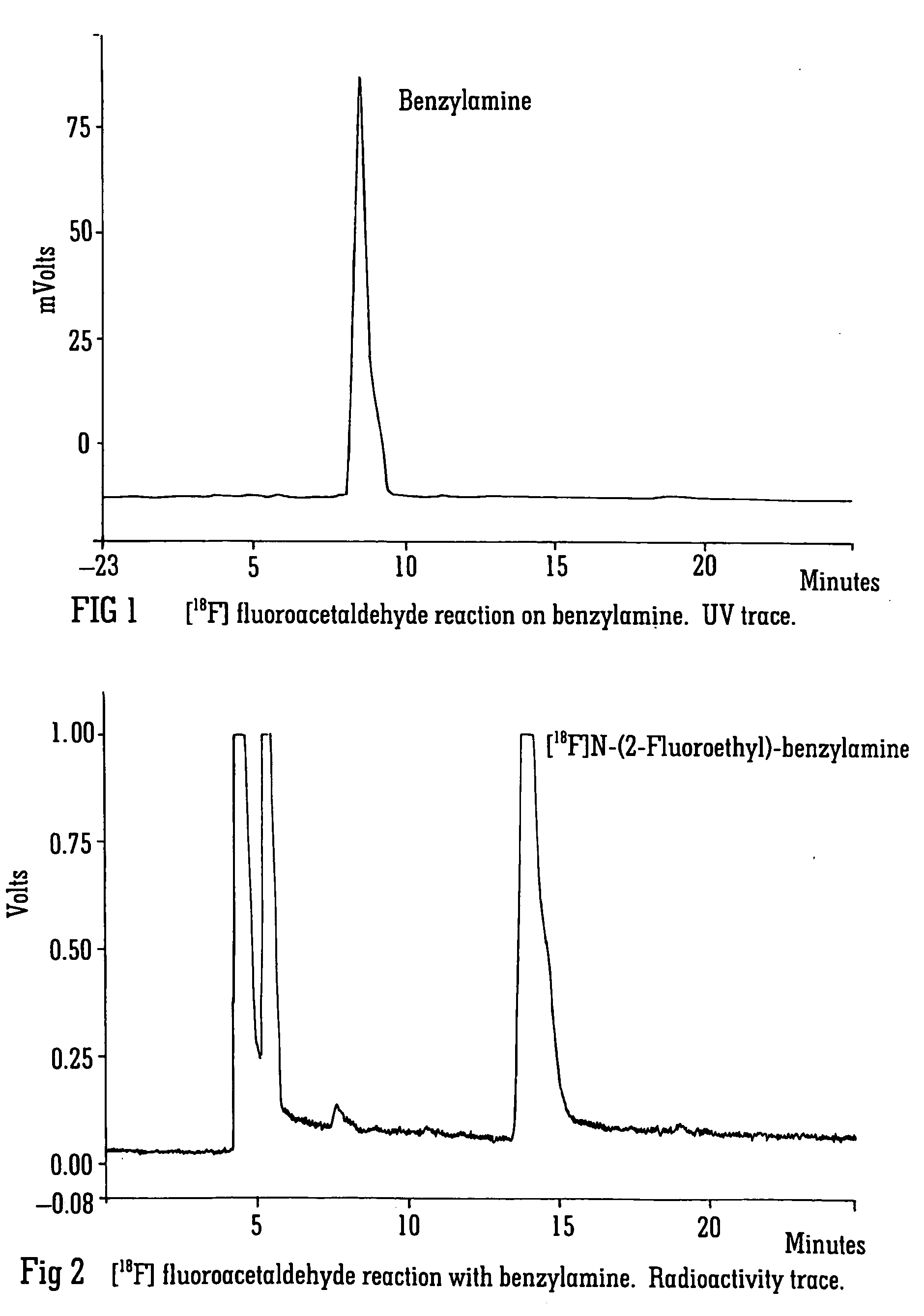Radiolabelling
a technology of radiolabelling and radiolabelling, which is applied in the field of radiolabelling with 18f, can solve the problems of difficult automation and difficult implementation in routine production, and achieve the effects of reducing energy consumption, shortening half-life, and reducing energy consumption
- Summary
- Abstract
- Description
- Claims
- Application Information
AI Technical Summary
Benefits of technology
Problems solved by technology
Method used
Image
Examples
example 1
General
[0054]Chemicals and solvents were purchased from Sigma-Aldrich Company Ltd. (Gillingham, UK) and were used without further purification. The aldehyde colorimetric test kit (formaldehyde-test) was purchased from Merck Chemicals Ltd. (Nottingham, UK). HPLC solvents and a ready-to-use commercial cyanoborohydride phosphate buffered saline solution (Cyanoborohydride Coupling Buffer) were obtained from Sigma. The coupling solution is made up of 0.02 M sodium phosphate, pH 7.5, containing 0.2 M sodium chloride and 3.0 g / L sodium cyanoborohydride. Wheaton borosilicate screw-top V-vials, capacity 3.0 mL and 1 mL, with open-top cap and PTFE faced silicon septum and heat transfer block from Aldrich were used for the radiosyntheses.
[0055]Thin layer chromatographies (TLC) were performed on Fluka silica gel plates (20×20 cm, 250 μm thickness). Radio-TLC plates were analysed with an instant imager (Packard).
[0056]Analytical high performance liquid chromatography (HPLC) was carried out on a ...
example 2
Radiolabelling of an Apoptosis Biomarker with [18F]fluoroacetaldehyde
[0073]A gel was produced by addition of the apoptosis biomarker (1 mg) in solution in 50 μl of citrate buffer (citric acid, ˜0.060 M, sodium hydroxide, ˜0.16 M, pH=6) and 10 μl of a 1 M solution of sodium cyanoborohydride in citrate buffer onto the dry polysaccharide (Sephadex® G-75, 4.5 mg).
[0074][18F]fluoroacetaldehyde was distilled onto the cross-linked polysaccharide gel containing the apoptosis biomarker and sodium cyanoborohydride (reducing agent).
[0075]After 8 minutes all of the [18F]fluoroacetaldehyde was distilled, as monitored by a radioacte detector. The reaction vial was then heated at 37° C. for 45 min after which phosphate buffered saline (1 ml, pH 7.2) was added to the reaction mixture using a programmable syringe pump for infusion and withdrawal. The suspension was then withdrawn and injected into a HPLC, by the syringe pump via a low protein binding filter for purification.
[0076]FIG. 7a shows the r...
example 3
Radiolabelling of an Anti-VEGF Antibody with [18F]fluoroacetaldehyde
[0078]A gel was made by addition of 20 μl (0.5 mg) of the solution of antibody formulated for infusion, and 40 μl of a 0.25 M solution of sodium cyanoborohydride in citrate buffer (citric acid, ˜0.060 M, sodium hydroxide, ˜0.16 M, pH=6), onto dry polysaccharide (Sephadex® G-75, 4.5 mg).
[0079][18F]fluoroacetaldehyde was then distilled onto the polysaccharide (Sephadex® G-75) gel.
[0080]After 8 minutes all the [18F]fluoroacetaldehyde was distilled, as monitored by a radioactivity detector. The reaction vial was then heated at 37° C. for 45 min after which phosphate buffered saline (1 ml, pH 7.2) was added to the reaction mixture using a programmable syringe pump for infusion and withdrawal. The suspension was then withdrawn and injected into a HPLC, by the syringe pump for purification via a low-protein-binding filter for purification.
[0081]FIG. 8a shows the results of the HPLC analysis of the radiolabelling reaction u...
PUM
| Property | Measurement | Unit |
|---|---|---|
| polar | aaaaa | aaaaa |
| PET | aaaaa | aaaaa |
| specific radioactivity | aaaaa | aaaaa |
Abstract
Description
Claims
Application Information
 Login to View More
Login to View More - R&D
- Intellectual Property
- Life Sciences
- Materials
- Tech Scout
- Unparalleled Data Quality
- Higher Quality Content
- 60% Fewer Hallucinations
Browse by: Latest US Patents, China's latest patents, Technical Efficacy Thesaurus, Application Domain, Technology Topic, Popular Technical Reports.
© 2025 PatSnap. All rights reserved.Legal|Privacy policy|Modern Slavery Act Transparency Statement|Sitemap|About US| Contact US: help@patsnap.com



